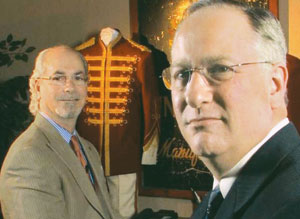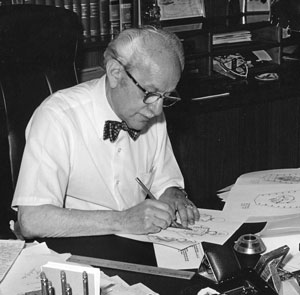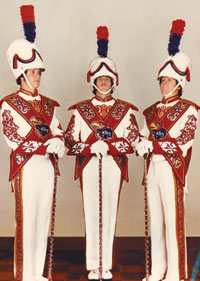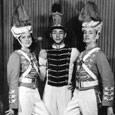 Herman Fruhauf came to America from Vienna, Austria in the early 1900s and settled in New York. He moved to Wichita, Kansas in 1907 and worked at a department store as a tailor and window dresser. One day a gentleman came in to have a suit fitted and began talking with the store owner. He mention that he had formed a town band and needed some uniforms and asked if the store knew anyone who could make them.
Herman Fruhauf came to America from Vienna, Austria in the early 1900s and settled in New York. He moved to Wichita, Kansas in 1907 and worked at a department store as a tailor and window dresser. One day a gentleman came in to have a suit fitted and began talking with the store owner. He mention that he had formed a town band and needed some uniforms and asked if the store knew anyone who could make them.
The store owner declined but while fitting the man’s suit, Herman said he could make the uniforms. This was the start of how the family entered the uniform business. Most of the sales in the early years went to local town bands.
In 1910 Herman officially began doing business as Fruhauf Southwest Uniforms. Initially there was just a storeroom, several machines, and a few operators. This part-time business with only regional customers grew into a full-time nationwide enterprise. They also began to make uniforms for fraternal organizations. The company made uniforms for the government and during World War II manufactured many thousands of dress blue military uniforms.
 Herman’s son Lou actually developed an orange flight suit for military personnel that were transporting servicemen between land and ship because the bright color would be easier to spot in case they went down. Other notable products made over the years were uniforms for the Marine Band and for the Blue Angels flying team (the flight suits they wore on the ground for interviews) as well as for the President’s helicopter team. The company made its last uniforms for the military in about 1968. Since then the company has focused on music uniforms that range from outfits for drum majors to concert attire. Starting in the late 1960s Fruhauf manufactured lightweight, washable uniforms for drum corps. When polyesters became popular, Fruhauf was instrumental in introducing lightweight flowing tops, known as corps blouses.
Herman’s son Lou actually developed an orange flight suit for military personnel that were transporting servicemen between land and ship because the bright color would be easier to spot in case they went down. Other notable products made over the years were uniforms for the Marine Band and for the Blue Angels flying team (the flight suits they wore on the ground for interviews) as well as for the President’s helicopter team. The company made its last uniforms for the military in about 1968. Since then the company has focused on music uniforms that range from outfits for drum majors to concert attire. Starting in the late 1960s Fruhauf manufactured lightweight, washable uniforms for drum corps. When polyesters became popular, Fruhauf was instrumental in introducing lightweight flowing tops, known as corps blouses.
“Our whole philosophy is that regardless of how a band acts or sounds on the field, the uniform has a sense of immediate respect and will impress viewers,” according to Ken Fruhauf, great-grandson of the founder and currently the company president. He remembers stories from his father and grandfather about calling on school board meetings in the 1950s and 1960s. Several other vendors would be present, and each had 30 minutes to display and promote their wares. For a tux overlay, a West Point uniform, and a concert uniform, the cost was $65.95. These were all 16-ounce wool uniforms.
If we met the board’s price, they gave the order on the spot and measuring began the next day. There were no bid specifications, but a board member might test a sample by pulling on a sleeve three times. If it fell off, that vendor was out. If it took seven times to dislocate, this earned the order.
Changes in Uniforms
Today, many uniforms still maintain a militaristic look but with the modern twists of more blocks of color and lots of flowing sections. The rigid West Point look is less common today, and the garment is generally form-fitted and lighter weight. The choreography on the field entails more dance and movement than the basic 8 to 5 high marching step. The dance line and color guard add a theatrical touch to shows, and the garments have to be easy to wear on the field. There are fewer buttons, less braid, and sometimes less detail if the style uses large blocks of color. The use of gauntlets and more hand movement is more prevalent than before, and plumes are taller to make students look taller and thinner.

Fruhauf has survived for a century that saw the passing of major uniform makers as Ostwald, Sol Frank, and Fechheimer. With up to 165 employees, Fruhauf is busiest from March through October, but sometimes receives last-minute requests. The marching band director at Northwestern University called in mid-October 1995 to explain that the university president had just called the dean of the music school and insisted that the band wear new uniforms for its Rose Bowl appearance.
“I flew to Chicago to measure the band, and the purchase order was signed the following week. I told director Steve Peterson that if he saw me at the Midwest Clinic just before Christmas that it meant the uniforms had shipped. If I was not there it meant I was still in the factory making the uniforms,” Ken Fruhauf explains. He made it and shipped the uniforms in less than seven weeks.
Fruhauf commends his competitors who helped supply the needed fabric and braid, which manufacturers were unable to supply on such short notice. “We have a wonderful relationship with our competitors: if one of us cannot get supplies in time to fulfill a contract, others will share from their excess inventory. We have had this good working relationship with other uniform makers for 70 or 80 years and this says a great deal about the uniform business.” The Instrumentalist extends the best wishes of the music industry to Fruhauf Uniforms for a century of progress.





